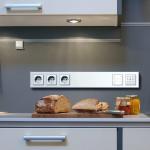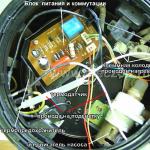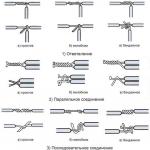Household electrical appliances are widely used throughout the world and one of the most common electrical appliances is the electric kettle. Despite the reliability of many models and manufacturers, the service life of electric kettles, like other electrical appliances, is limited, so kettles break sooner or later. And in this case, it is not necessary to take the kettle for repair or purchase a new one - you can repair the electric kettle with your own hands. In this article, we will discuss with our readers how to repair the most common breakdowns in electric kettles.
The principle of operation of the electric kettle
Before undertaking the repair of any electrical appliance, it is necessary to understand its principle of operation - this rule also applies to the kettle. According to the electrical diagram, it is easy to understand the principle of operation of this electrical appliance. Note that almost all models work according to the principle of operation below.
The principle of operation is as follows: after connecting the plug to the power source, the current passes through the wire to the contacts of the stand, on which all kettles are installed when water is heated.
At the base of the kettle itself there are special contacts that are connected together with the contacts located on the stand - in this way the circuit is closed and the heating element is heated. The electricity then passes through a thermal switch, a device that allows the kettle to turn off when it reaches a certain temperature (usually the boiling point). Also in the standard circuit there is a thermal protection switch, which is always on and is activated only if the user turns on an empty kettle. From the marked switches, electricity passes directly to the electric heating element (also called the heating element).
We have examined the basic principle of operation of an electric kettle - now we will consider separately the operation of some of its circuits and sections.
Wiring diagram of nodes
Carefully consider the stand for the kettle and the place of its contact with the kettle itself. Inside the circular grooves, you can find an electrical contact located on a small spring. It is through this contact that the voltage from the common network is supplied to the electric kettle itself. In the center of the stand there is another contact, which, when in contact with the electric kettle, grounds its case. In fact, this contact does not play any role and is intended only to protect the user in case of violation of the integrity of the insulation.
The power cord that goes to the stand of the electric kettle, inside this stand, branches into three wires, to which the terminals are connected. One wire is for grounding, the other two wires go to concentric copper rings that are used to transfer electricity from the stand to the kettle itself. Further, electricity from copper rings goes directly to the heating element, which is installed at the base of the kettle body. As a result of the closure of the circuit, the water is heated.
overheat protection
Heating elements have high power and get very hot during operation, therefore, a special protection system is additionally installed in each electric kettle. The basis of this system is bimetallic plates, which, when heated to a certain temperature, unbend and open the circuit, thereby preventing further overheating of the kettle.
Automatic shutdown
Almost all modern electric kettles have a special system that provides for turning off the heating element from voltage when the water reaches the boiling point. The principle of operation of such a machine is simple - when heated, steam is supplied through a special channel to a bimetallic plate, which in turn is connected to a switch. When the kettle boils and at an increased intensity of steam pressure, the bimetallic plate heats up and presses on the switch lever, thereby disconnecting the kettle from the mains.

How to repair a kettle?
We examined the main technical features, and now we will consider how to repair an electric kettle. For the convenience of readers, let's consider specific examples that most often arise with teapots from various companies (Tefal, Philips, etc.):
- Kettle stopped heating water. In this case, the malfunction is very easy - there was a break in the section on the heating element itself, or there is no contact of some terminals with the terminals on the heating element. The connection is restored very easily - for this you need to disassemble the kettle and determine the place where the contacts left off. When determining the place of lack of contact, it is necessary to restore the connection of the terminal with the terminals on the heating element using pliers.
- The kettle stopped heating water and the indicator does not show that the kettle is on. First of all, we check the voltage in the network. If there is one, the reason is poor contact between the current collectors at the base of the kettle body and the stand. In this case, it is necessary to check how the spring-loaded contacts, which we talked about above, are holding. To do this, the stand is disassembled and a ring with a suitable contact is taken out. It is necessary to check how tightly they are fixed - as a rule, they become loose over time and you simply need to tighten them more tightly in order for electricity to pass through the contacts.
- Switch or overheating protection does not work. When considering how to repair an electric kettle, most often in practice they encounter a non-working switch. It may be broken due to the wear of plastic parts, rust on the surface of the bimetal plate. To check the condition, it is necessary to remove the switch from the housing and check the integrity of the parts. After that, it is necessary to inspect the condition of the plates. If there is a strong deposit from steam or rust on them, it must be removed and the operation of the switch should be checked again. These measures are also taken if the overheating protection stops working (in other words, the kettle stops turning off) - it is necessary to check the condition of the bimetallic plates and, if necessary, clean them.
- The kettle is leaking. In this case, it is necessary to check the integrity of the kettle body and see where the leak comes from. As a rule, if there is a strong leak, it may not be possible to talk about repairing the kettle, especially if its body is made of low-quality plastic or the inner surface has been badly damaged as a result of damage.
Repair of electric kettles from A to Z and 7 ways to determine the breakdown
Repair of electric kettles is required quite often Buying any electrical equipment, you will never guess the term of its operation. An electric kettle is one of the household appliances that is used to the maximum in the household and sooner or later it may break down. But it is important to be fully prepared and, if a breakdown is detected, do not run to the store for a new device, but try to independently identify the cause and, if possible, eliminate it - this is real. And how exactly to safely and easily eliminate the breakdown of the electric kettle will be described later.
Search for the cause and repair of kettles
Repairing electric kettles is a fairly simple procedure that you can handle with your own hands. When repairing a kettle, it is very important to know how to find a breakdown and how to safely repair it. Often the failures of all kettles are the same: either it does not heat the water or it simply does not turn on.
Since many teapots are now imported from China, the durability of their work leaves much to be desired. Breakdowns are less common in Bosch kettles.
Repairing electric kettles can sometimes be a very exciting experience. For example: if the handle with the lid is one-piece and attaching them separately outside the kettle does not work, because the bolts on which it is all attached are glued near the edge of the door. Even many experienced craftsmen think, how did the Chinese collect all this?
Repairing an electric kettle can be a fun activity
The scheme for searching for the cause of a breakdown in electric kettles:
- Before you fix the device, you need to investigate the mechanism of its operation. There are a lot of manufacturers of electric kettles, but they are all assembled according to the same principle: through the socket into the kettle, the contact group (the thermostat located in the spiral base of the kettle) with the help of which the water is heated transmits voltage.
- Be sure to make sure that it is disconnected from the power supply before disassembling the device.
- It is necessary to check the integrity of the contacts near the heating coil of the kettle.
- Boiling with the lid open can cause the kettle to break down, as a result of which the plate in which the heating element is installed does not bend and damages the highly heated heating element. As a result of such a breakdown, the thermostat will have to be replaced.
- To repair a Tefal kettle that does not turn on, it is necessary to clean the heating element (which is hidden behind the disc element) from scale with a special descaler.
- If the kettle button does not work, then this may mean a breakdown of the thermostat or resistor (5w12kj), which is responsible for the operation of the heating circuits.
- When the electric kettle stops heating, it is necessary to free it from water, then turn it over, first disconnecting it from electricity and turn on the switch on the stand, which is represented by a button.
If the contacts connecting the thermostat to the electrical plug are broken, they must be connected and sealed with insulating tape.
Do-it-yourself electric kettle repair
The principle of operation of the electric kettle is the electric heating element. The bimetal plate is responsible for the release of steam, which heats the water and automatically turns off when the water boils in the kettle. But what to do if the kettle breaks? In the past, a broken kettle caused many problems, but in modern times, it is not difficult to eliminate this problem.
If a new kettle leaks, it is not necessary to replace it with a new one. You can wait a few weeks until scale forms on its bottom, which will cover all the cracks inside. If the kettle drips heavily, then you need to contact the service center.
If the kettle is broken, you can repair it yourself
Basic rules for do-it-yourself teapot troubleshooting:
- If the kettle is leaking, the case may be defective. To eliminate water leakage from the kettle, you can use a special sealant and glue to seal microcracks.
- It also happens that the kettle has not yet boiled, but the light has already turned off. To do this, it is not necessary to know how the principle of operation works, but just to clean it from scale. This problem is often found in Scarlett and Polaris kettles, and Braun and Maxwell kettles have a self-cleaning and filtering system.
- If the kettle light is not on, then it is necessary to clean the contacts inside the kettle, which could be oxidized.
- If the kettle does not work, it must be directly connected to the network and make sure that the outlet is working.
- The electrical circuit of the kettle is quite simple and similar to the operation of the iron. There are not many parts in the kettle that can break. In the event of a breakdown, first of all, it is necessary to deal with the heater, which is usually changed to a new one.
If the kettle does not heat, then it is necessary to look for the direct cause of the breakdown in faulty contacts.
Electric kettle diagram
The device of the electric kettle circuit, as in any heating element, is quite simple. Any electric kettle has a heating element and a thermal switch - these are the main working mechanisms. Electric current enters the heating element, and heat is transferred from the spiral to the heating element, the water heats up, and the kettle automatically turns off.
It is very important to pour water into the kettle not higher than the maximum mark, otherwise, when boiling, it will spill, and not lower than the minimum, otherwise, if the heating element boils, it may fail and you will have to change it. Kettles Brown and Bosch have a unique system of protection against such damage.
Electric kettle diagram
Electric kettle scheme:
- The main element of the electric kettle is the heating element, which is responsible for the heating capacity of the kettle, it is located under the metal plate of the kettle. If this element stops heating, it should be replaced.
- Inside the heating element there is a network spiral, which heats up and supplies heat. Why does the spiral supply heat to the heating element? due to electrical resistance. Its replacement in the event of a breakdown is also not difficult.
- The button for turning on the kettle is filled with LEDs and is covered with plastic. Dismantling the handle of the kettle in case of breakage can take a long time.
- Some kettles have a switch that is controlled by a timer.
- To connect the kettle to the network, a group of contacts is used, located at the bottom of the stand and turning into an electrical plug.
- The lid of the kettle is responsible for blocking hot water.
A thermal relay or a temperature heating sensor, which is responsible for heating it to a certain degree, can also cause a breakdown.
Electric kettle device
It seems that studying the device of an electric kettle takes a lot of time, and troubleshooting it at home is impossible, and now the kettle will have to be returned under warranty, but this is actually not the case. The cause of the breakdown can be identified independently. First you need to check if the plug is plugged into the network. If this worked and the water does not boil, you need to unplug the kettle from the electricity and inspect the thermostat in the stand below for scale.
Scale is easily removed by boiling a solution of citric acid in a kettle. If the heating element burned out, it should be replaced.
What should be done if the kettle is leaking? There may be several options: either wait a certain time for 2-3 weeks, until scale forms on it, cover the resulting microcracks with a specialized sealant and glue, or contact a service center and replace the device. It often happens that the button for turning on the kettle does not work, perhaps its luminous element has broken.
If you cannot fix the malfunction of the electric kettle with your own hands, you need to contact the service center
Common causes of breakdowns of electric kettles Scarlet, Saturn, Tefal, Vitek:
- The breakdown may consist in the oxidation of the contacts that are in the handle;
- Oxidation of the contacts that are in the relay;
- Damage to the wire in the electrical cord, the contacts must be stripped and reconnected;
- Damage to the contacts at the base of the electrical plug itself;
- Power button not working.
Progress is running forward and now cordless kettles have become very popular, but they can also be faulty, although they have written off wired electric kettles from many homes.
Cordless kettle Vitek and the reasons for its breakdowns:
- Contact damage;
- Breakage of the switch;
- Breakage of the heat of the heater or coil;
- TENA failure;
- Burnt contacts in the power button (in this case, it is better to replace the button with a new one);
- Thermal fuse failure.
Step by step: do-it-yourself electric kettle repair (video)
A kettle is an indispensable household appliance in the everyday life of every home, because it's nice to wake up in the morning with a fragrant cup of coffee. And how it spoils the mood, if suddenly our household assistant - an electric kettle, suddenly stops heating water, but thanks to the elementary scheme of the electric kettle, repairs can be done independently and enjoy the taste of an invigorating drink without any problems. Do it yourself, or contact the service - it's up to you.
Similar content


Electric kettles have firmly entered modern life, being the main device in any kitchen. They have a wide variety of shapes, their bodies are made of high-quality heat-resistant plastic or stainless steel. Most models, when water boils, can be turned off automatically, while there are those that are turned off manually. They are of different colors and with different functions, while all of them tend to break. Not always repair of electric kettles may be worth it, in some cases it is cheaper to purchase a new device. In this case, before going to the store, it is better to contact the service center, where diagnostics will be carried out, the causes of the breakdown and the possibility of their elimination will be determined. One of the most common problems that can occur in the operation of an electric kettle is that the device has stopped heating water. What is the reason and what needs to be done to make sure of this?
The most banal reason may be a faulty plug, which needs to be checked for serviceability. A break in the power cord will also cause the kettle to not heat water. In this case, it is necessary to check the serviceability of the cord using a tester, and if it turns out that the wires are broken, replace it with a new one. No power supply. It is necessary to check the operation of other household appliances in the kitchen. If they also do not function, the fastest thing is that the protection on the power panel worked - the fuses burned out or the machine turned off. Water will not heat up if the switch on the device is not fixed in the on position. This can happen due to severe wear of the switch, which will not turn on. It will have to be replaced, and it is better to do it in a service workshop, where the repair of electric kettles of this kind is a common thing. The electric kettle will stop heating water if the protection against its overheating is triggered. This can happen if the device continues to operate after all the water has boiled away. In this case, it is worth waiting ten minutes for the kettle to cool down and turn on again. A faulty heating element will also cause the appliance to malfunction. Each user should be aware that the formation of scale on the heating element shortens its service life as much as possible, which means that it must be periodically descaled. A failed heating element can be replaced with a new one, but only the service workshop master can determine whether this is really the case. If the stand of the electric kettle is out of order, it is necessary to remove the cover from the stand of the kettle and inspect the contact connections and wires. If they are burnt or damaged, they will have to be cleaned and bent. The same check should be carried out with the contacts directly on the electric kettle itself, after removing the cover on the bottom of the device. Then assemble the kettle and check its operation.
Drinking a cup of hot tea or coffee is always pleasant and healthy, especially when it's cold or raining outside. Some people cannot even imagine starting the day without a cup of invigorating coffee.
Well, to heat the water for these drinks, an electric kettle will help, and without it in any way. Unless, of course, you have a gas stove at hand, or an expensive coffee maker.
Therefore, a breakdown of an electric kettle can negatively affect both the productivity of work and the quality of the whole life of such people.
It is worth noting that it is electric kettles that occupy the main, leading place, as devices for heating water in the workplace.
Therefore, it would be useful to know the main possible breakdowns of kettles and methods for their elimination.
One such kettle will be discussed in this article.
One fine day, this device stopped heating water, moreover, the power lever stubbornly did not want to become in the “on” position.

When trying to do this, it was simply thrown back to the “off” position, that is, it worked as a reverse spring. Also, when forcibly holding the lever in the on position, nothing happened. The heater did not warm up, the device operation indicator did not light up. The indicator in this type of teapot is the blue LED light on the glass bowl.
The ringing of the cord and stand did not give anything, they turned out to be serviceable.

But this was not so important, because it was clear that the problem was 90% in the shutdown lever and its details. After all, it is his contacts that receive the main “strike” of the electric arc when the device is turned off.
So, you can start disassembling. To do this, it is enough to have a Phillips screwdriver.

We put the kettle on its side or bottom up and unscrew all the screws around the perimeter of the sole.

There are three screws inside the circle and four outside.

We fold the screws separately by type, so that when assembling they do not spoil the threads already cut by them in the body of the kettle, using the wrong screw.
Further, in order to get to the side screws that also hold the bottom of the kettle, you need something sharp (screwdriver, knife), tuck the cover from below and slightly pull it towards you, thereby releasing the latches.


So, free access to these screws will be possible.
We take the pad slightly to the side, and unscrew the hidden fastening screws.
After, clasping the lower part of the kettle with your hand, carefully remove it by passing it through the “foot” of the switch.


There are no elements on the sole itself that require detachment, so it is removed and set aside.


Now, you can see the entire "stuffing" of our kettle, as well as get to the necessary components for diagnostics and repair.

Two pairs of thin wires depart from the electrical module, with which you should be as careful as possible. They power the glass bowl's two LEDs and can be severely damaged by frequent bending. Therefore, when removing and inspecting this module, it is advisable to try not to bend these places once again.

Next, look at the switch control knob. Several levers depart from it, which act on the contacts, thereby turning the latter on and off.

In any case, to get even further and make a thorough inspection of the contacts, it is necessary to unscrew the screws securing the module and remove it.


At the bottom of the module there are bimetallic plates that, in contact with the heating element, automatically disconnect the device from the mains when boiling or overheating.

A ceramic rod departs from the plates, it then presses on the contacts when the bimetal is deflected, thereby breaking the circuit.

The first plate disconnects the contact when boiling, the second - when the sole is very hot, for example, when there is no water in the kettle, or when the first plate breaks.

Carefully examining the first plates with contacts, it was noticed that they were burnt.

Also, when trying to connect the contacts, by turning on the control lever, it was noticed that this does not happen due to insufficient bending of the contact plates.
By doing this with a screwdriver directly, it became clear that the movable plates became immobile, due to the melted plastic, which drained, formed a bulge between the lower and upper contacts, preventing them from connecting.

Using a thin screwdriver, the bulge was removed, and the contacts were cleaned with a thin knife.


To make it convenient to clean, you can bite off the plastic edge opposite the contacts with wire cutters. This will enable further cleaning without much effort and interference.

If the movable contact, when turned on, still does not connect to the fixed one, you need to slightly lower the second one. It will be convenient to do this by first removing the bimetallic plate, moving it slightly to the side.


Next, put the module on a flat surface and pointing the tip of the screwdriver on top of the contact, make a few short blows with your hand on its handle.

After that, we check the short circuit when turned on with a tester.
By the way, this can be done by connecting the ends of the tester to two ring contacts on the connecting socket. The center pin is the "ground" or body of the kettle. When the switch is on and the working heater is on, these contacts should ring short.

If the device does not show the connection, repeat the bending procedure again until there is a reliable closure of the contacts.
Do not hit the screwdriver handle hard with a hammer, otherwise you can simply break the plate and lose your last hope of bringing the kettle back to life.
At the moment of bending, you can pull out the ceramic rod so as not to accidentally break it. After, you need to insert it back and install the plate.
Now, we fasten the module to the sole of the heater and place the kettle on the stand. Having typed some water into the kettle, plug the plug into the socket, and the switch to the “on” position.



If everything is done correctly, water boils under blue decorative lighting.

Next, turn off the plug and thread the glass lever through the cutout in the case, put the plastic sole in its place.

When installing, a very important point is the correct docking of these two parts. As shown in the photo, when the lower part is supposedly inserted, you need to press your finger on the notch at the top of the lever.

There is a click, and the two parts dock correctly and finally. If this is not done, at the end of the assembly, the power button will not turn on again, because the lever system will rest against the sole and prevent it from moving. You will have to disassemble the entire kettle again, which is very undesirable.
Now, install the handle.
The photo shows that the device is working, and the water boils.

Also, the kettle should turn itself off. And so it happens.

We can assume that the repair was successful and this wonderful device will please its owners with an invigorating, warming drink more than once.
An electric kettle is the most common household appliance that every family probably has today. Its popularity is due to the speed of boiling water, which is superior to other heating methods. Therefore, these simple devices have won a special place for themselves not only in the household, but also in offices and other workplaces where you can enjoy hot tea or coffee during a break. But, like any other technique, an electric kettle can also fail, and its owners will probably have a question, is it possible to fix this device with your own hands, without contacting a repair shop?
The device and principle of operation of electric kettles
An electric kettle is a household appliance, the design and principle of operation of which can be understood even by a person who knows little about technology. All kettles are arranged in the same way, regardless of the model, and work according to the same scheme. They consist of the following main nodes and elements:
- a case, which is also a flask for water (some models of electric kettles have a separate bowl placed in the case);
- a heating element in the form of an open spiral, similar to a boiler, located directly at the bottom of the water tank or (like most modern electric kettles) in the form of a disk heating element;
Such a heating element is located at the bottom of the water flask.
On the inside, the disc has a smooth surface
- stand (base), on which there is a connector for connecting a kettle and a power cord for connecting to a household electrical outlet (all modern electric kettles that are cordless have it);
Base available on cordless models only
- power connector pads on the bottom of the kettle base, which can be central (like most models) or lateral;
- a thermostat used to turn off the kettle when boiling;
This type of thermostat is installed under the button
- power buttons.
Today on sale you can find electric kettles with a thermostat, with which you can heat water not only to 100 ° C, but also to any desired temperature, and even maintain this temperature for a certain time. This property is necessary for the correct brewing of various types of tea (black, green, white, red), each of which requires water of different temperatures from 60 to 90 ° C. An electric kettle with a thermostat is an ideal purchase if there is a small child in the family. Indeed, for the preparation of baby food mixtures, boiling water is not required, and with the help of such a device, you can set the desired temperature. And for adults, repeated boiling of water is highly undesirable if they adhere to a healthy diet.
In this model, the control panel is located on the stand
Naturally, each model of electric kettles has its own design features, but they do not differ fundamentally in terms of design.
The principle of operation of an electric kettle is also quite simple. When heated, the heating element heats the water in the flask until it boils. Steam is supplied through special channels to a bimetallic thermostat plate made of metals with different coefficients of thermal expansion, it, bending, presses on the button lever or opens the contact terminals, disconnecting the device from the mains.
The diagram shows the movement of steam through the channels in the handle, but a tube in the kettle flask itself can also be used for this purpose.
The most common faults
For electric kettles, the following malfunctions are typical:
- Leakage in the housing of the electrical appliance. This malfunction is more typical for kettles with a plastic case, as well as those equipped with a disk heating element. In the first case, the breakdown may be the result of deformation of the kettle from overheating at the place where the heating element is attached, and with disc heaters, the cause is corrosion along the seam connecting the disc to the body of the electric kettle. Often the cause of such a breakdown is a worn-out seal or cracked glass of the water level indicator.
Failure of the heating element. The cause of the defect is the scale formed on the heating element, as a result of which the transfer of heat to water is difficult, and the coil itself heats up. Most of all, heating elements of a spiral type are more susceptible to such a breakdown than disk-type heating elements, which take longer to form a critical layer of scale. The reason for the burnout of the heating element can also be a violation of the operating rules, for example, if the kettle is plugged into the network, forgetting to pour water into it.
Broken electric kettle button. Two reasons are possible here - the formation of soot and oxidation on the contacts of the button or a break in the thrust connecting it to the power supply terminals.
Premature shutdown of the appliance. This malfunction is a consequence of scale. The water does not have time to boil, and the heating element has already overheated and the thermostat disconnects the device from the network.
Failure of the thermostat. In the design of electric kettles with a thermostat, there are additional components and parts - a thermometer, temperature sensors, a memory unit, an electronic board and a control panel. The more parts a device has, the lower its reliability and the higher the likelihood of any of them breaking. In teapots with thermostats, the regulator itself most often fails, in which the contacts oxidize or burn.
Breakdowns that allow you to return the electric kettle to the store
You can return a faulty electric kettle to the store during the warranty period, if during this period its significant shortcomings have appeared, namely, malfunctions of the following nature:
- irreparable damage;
- recurring failure of the same node;
- a breakdown that cannot be repaired without disproportionate costs close to the cost of the kettle itself;
- a malfunction that takes a long time to resolve, as a result of which the device cannot be used for more than 30 days during the year.
There may be a variety of malfunctions, but the most serious of them are leaks not associated with mechanical damage and a leaky gasket, but caused by deformation of the housing or damage as a result of corrosive processes.
Failure of the heating element can also be attributed to significant breakdowns, provided that the kettle has been properly operated and there is no scale on the heating element.
Electric kettles are household appliances that are included in the list of technically complex products. Therefore, it is possible to return them back to the store, with a refund of the money paid, only if they are of inadequate quality. When contacting the store with a written claim, you need to indicate a breakdown that often repeats or requires costs. comparable to the cost of an electric kettle.
The seller has the right to offer the buyer to contact the service center, but if the breakdown has not been fixed within 20 days, the store is obliged to return the money or exchange the device for a new one. The seller also has the right to appoint, at his own expense, an examination of the goods, which will determine whether the failure occurred due to the fault of the user or whether it is the cause of a manufacturing defect. In the first case, all costs for the examination must be reimbursed by the buyer. In the event of a defect due to the fault of the manufacturer, you can demand not only a refund, but also compensation for moral damage. Moral damage can be claimed only by a court decision.
Diagnosis of malfunction of electric kettles
To determine the reasons for the breakdown of the electric kettle, you only need a screwdriver, which is necessary for disassembling it, and an electrical measuring device - a multimeter or an avometer. The procedure for diagnosing this device is quite simple. It consists in the sequential ringing of the electric chain of the kettle, starting from the plug connecting it to the electrical outlet, and up to the heating element.
Check by tester
If the electric kettle does not turn on, does not heat up, and does not even light up the operation indicator lamp, the diagnosis of the device, no matter how strange it may sound, must be started by checking for voltage in the electrical outlet into which the device is connected. To do this, you can turn on any other known working electrical household appliance to it or measure the voltage with a tester.
If there is voltage in the network, you need to diagnose the kettle itself. This will require:
- Check the serviceability of the plug for connecting the appliance, the connecting cord and the contact group on the stand to which the electric kettle is connected. In the ringing mode, having finished one probe of the multimeter with the pin of the plug, with the second probe we alternately touch the contacts on the base connector. As a rule, there are three of them, and they correspond to two conductive wires and a grounding contact, which is closed to the body of the device. On a stand, they can be located in the middle in the form of circles or on the side in the form of a three-fingered connector. On which contact the signal of the device sounds, it corresponds to the pin of the plug, which indicates the integrity of this cable core and contact groups. We repeat the same operation for the second pin on the plug and the ground contact. If the ringing goes on all three lines, then the base is working and can be put aside, starting to diagnose the kettle.
- Since the malfunction lies in the electrical appliance itself, you need to remove its bottom cover. To do this, you need to unscrew three screws (sometimes there are more - 4 or 6).
- The next step is to ring the power connector terminal block at the base of the kettle. Usually it is combined with a thermostat, and planted on thermal paste. Before unscrewing it, disconnect the cable suitable for it. The left and right contacts of the block, when they are closed to the corresponding elements of the device connector, should ring, respectively, each on its own ring - internal or external. If this does not happen, you need to disassemble the block by removing the bottom plate of the thermostat, and clean the contacts with sandpaper or a needle file, removing carbon deposits and oxidation from them. Along the way, you need to check the availability of contact
After stripping the contacts, the block must be assembled and ringed again. If the defect is fixed, screw it into place.
- Next, the operability of the kettle on button is checked. To do this, we touch with one probe of the multimeter to the contact of the wire going to the button, and with the second - to the wire coming from the button to the heating element. When the switch is in the off position, there should be no reaction, and when the button is turned on, the device will beep, symbolizing that there is a circuit, which means that the button is working. Otherwise, it needs to be replaced or repaired.
- At the last stage of diagnostics, the health of the heating element is checked. To do this, you need to ring the output contacts of the spiral, to which the wires are connected from the central connector of the stand and from the button. If the ringing goes on, then the spiral is not broken. Finishing one of the outputs of the heating element with its body, you can check whether there is a short circuit of the broken spiral on the body of the heating element. If the device gives a signal, a breakdown on the body takes place, and the heating element is considered faulty.
Video: Diagnostics of an electric kettle with a multimeter
Diagnosis of a kettle with a thermostat
The presence of additional structural elements in electric kettles with a thermostat, compared to conventional appliances that can only boil water, somewhat complicates the diagnosis of devices that are more saturated with details. But the difficulty here can arise only when determining the health of the electronic board and memory unit. However, it is quite easy to determine that the cause of the teapot breakage lies precisely in the thermostat.
When diagnosing kettles that heat water to a certain temperature, there are two options for placing the control panel:
- in teapot stand
- on the appliance itself (usually on its handle).
Usually electric kettles with adjustable heating temperature have not three contacts in the connector of the base connection unit with the device, but five. Two more contacts for the thermistor are added to the power circuit for the heating element (two cable cores) and the grounding contact.
The ringing of a kettle with a thermostat is carried out in the same sequence as for a conventional electric kettle:
- First of all, you need to determine which of the contacts on the stand of the device correspond to ground and two cores of the power cable. To do this, in the dialing mode, after finishing one multimeter probe with a pin on the plug, the second one touches the contacts on the stand connector in turn. We repeat a similar operation for the second cable core and grounding.
- The remaining two contact rings included in the thermistor circuit must be checked for resistance. The device should show a certain resistance of about 100 kOhm. For other indications (1 or infinity), it can be concluded that there is a malfunction in the thermostat circuit.
- If everything is in order with the stand, you need to ring the kettle itself, as already described earlier. When ringing individual elements of the circuit (power button, heating element, terminal block with which the thermostat is usually combined), you must first disconnect the electronic part of the thermostat and temperature sensors.
Checking the coil of the heating element
Knowing the power for which the electric kettle is designed, you can easily calculate what resistance the spiral of its heating element should be. To do this, first calculate the current strength, which can be found by dividing the power in watts by the mains voltage (220 V). Further, according to Ohm's law, well known to everyone in the school physics curriculum, in order to find the resistance, we divide the voltage in the network by the current strength. For example, for an electrical appliance with a heating element power of 2000 W, the current strength will be 2000 W / 220 V = 9.09 A, and the resistance of the nichrome spiral is 220 V / 9.09 A = 24.20 Ohm.
The resistance of the heating element spiral obtained by calculation should not differ significantly from the actual one. To measure it, you need to remove the bottom cover of the kettle and measure it with a multimeter, setting it to the resistance measurement mode.
How to fix an electric kettle with your own hands
A fairly simple device of electric kettles allows you to fix many of their malfunctions on your own, without contacting service shops. But you can start repairing with your own hands only on the condition that the warranty period for the electrical appliance has already expired. Consider some of the most common problems that can be easily solved if there is a simple tool at home and, without fail, an electrical measuring device.
If the kettle began to leak, you must first of all, establish the place where its tightness is broken. It could be:
- leakage through the gasket installed at the junction of the disk heating element with the inner walls of the housing;
- water seepage at the place of attachment of an open-type heating element;
- flow on the glass of the level gauge, showing to what mark the water is poured into the kettle.
- the presence of a crack in the body of the electric kettle.
In the first case, the cause of depressurization of the flask may be a leaky gasket, or scale getting under the gasket. For any of these options, you must:
- Remove the bottom cover of the kettle.
- Detach the top cover, which is usually held on by latches and can be easily removed.
- Dismantle the heating element together with the gasket by squeezing it out by hand.
- Having removed the rubber gasket from the disk heating element, rinse the kettle itself, its heating element and the sealing ring well. If the latter has scuffs, tears and excessive wear, the gasket must be replaced with a new one.
- Dry the heating element with all parts attached to it well with a hair dryer.
- Assemble in the reverse order, and after filling the kettle with water, put it on a dry cloth for 15-20 minutes. If there are no more leaks, we can assume that the defect has been eliminated.
This process can be seen more clearly in the next video.
Video: Elimination of leaks in an electric kettle with a disk heating element
If a leak is found in an electric kettle with a heating element in the form of an open spiral at the place where the heating element is attached, it is necessary:
- Remove the bottom cover of the appliance housing, as well as the cover on its handle, to provide access to the heating element fastening nuts.
- If the fastener is loose, you need to tighten it and check if the problem is fixed.
- If the tightness is not restored by tightening the fasteners, you need to dismantle the top cover of the kettle and, having unscrewed the fastening screws, remove the spiral along with the gasket.
- Thoroughly clean the surface of the heating element adjacent to the gasket and the sealing ring itself from scale. If necessary, replace gasket.
How to disassemble a kettle with an open spiral heater and remove the heating element along with the gasket can be seen in detail in the following video.
Video: How to remove a spiral heating element with a gasket from an electric kettle
Leakage of the kettle on the glass of the level gauge may be the result of wear of silicone gaskets or the appearance of microcracks in the plexiglass itself. And if the problem with gaskets is solved quite simply (by replacing them), then to get rid of cracks, you will have to resort to glue.
For gluing plexiglass (or plexiglass), professional glue Acrifix 116 or 117, vinegar essence, Moment moment glue, as well as Сosmofen or Colakril adhesive compositions can be used.
With cracks in the body, it is better to purchase a new kettle, since any glue that you can try will be in contact with water, which is undesirable for health. The process of eliminating leaks on the glass of the level gauge can be seen in the following video.
Video: Eliminating the leakage of the kettle on the glass of the level gauge
The reason that the electric kettle does not turn off when boiling may be:
- not closed or loosely closed top cover;
- clogging of the hole for supplying steam to the bimetallic plate of the thermostat;
- button or thermostat malfunction.
After checking whether the lid is tightly closed, clean the steam outlet with a toothpick, which is located under the lid at the junction of the handle with the body. If the problem persists, you need to remove the bottom cover of the kettle, and then proceed according to the following algorithm:
- Remove the bottom cover of the body of the electric kettle, and the cover on its handle. A bimetallic plate, which should, by bending, turn off the button or access to electricity to it is available both on the button and under the terminal box of the kettle, where the thermostat is usually located.
- Make sure the integrity of the contacts and their ability to open under the action of a bimetallic plate. If the contacts have stuck to each other, or the pin that should open them has melted, you need to restore the operation of this system, and if it is impossible to eliminate the breakdown, replace the problematic part - a button or thermostat.
- Reassemble the device in reverse order and check if this problem is fixed.
Another problem that may arise during the operation of electric kettles is when the water has not yet boiled, and the device is already turning off. This defect can occur due to scale formed on the heating element, which prevents the transfer of heat to water and heats the coil itself. Overheating of the coil triggers a thermal fuse or thermostat at the base of the kettle. In this case, you need to descale the kettle, for which you can use:
- special household chemicals "Antinakipin" or Major Domus;
- coca-cola, which contains phosphoric acid;
- citric acid at the rate of 1 tbsp. spoon for 500 ml of water;
- baking soda 3-4 tbsp. spoons per 1 liter. water.
These solutions should be boiled in a kettle and held for 15-20 minutes, after which clean water should be boiled in it 3-4 times for washing.
If there is no scale on the heating element, you need to check the thermostat contact. It may be too close to the pusher of the bimetal plate, and you just need to bend it a little, as shown in the following video.
Video: What to do if the kettle turns off without boiling
There are times when the kettle does not turn on, which means that in some place there is a break in its electrical circuit. It can be associated with burning and oxidation of contacts. To eliminate the malfunction, you need to find the place of the gap, as it was already described earlier about troubleshooting.
If the electric kettle does not heat the water, and its light is on, this may signal a break in the nichrome spiral of the heating element or the burning of its terminals. In the first case, it will be necessary to replace the heating element, and in the second, cleaning the contacts.
A situation may arise when the button of the electric kettle is not fixed. The cause of such a breakdown is a jumped off, or burst spring. To eliminate the defect, you must:
- Remove the cover from the handle by unscrewing the screws under the top cover of the kettle, and prying with a screwdriver, release its latches from the grooves.
- Remove the button by disconnecting the wires from it and unscrewing the screw.
- Having disassembled the button, put the jumped spring in place.
- If the spring is broken, it will be easiest to replace the button with a new one, because it is unlikely that you will be able to find such a spare part.
- Assemble the kettle in reverse order.
Disc Heater Replacement
Electric kettles with disc heaters are particularly vulnerable to rust, which corrodes the metal, damaging their surface and breaking the tightness of the appliance. With such a defect, the device is not operational. The only way out is to replace the disk, for which you need:
- Remove the bottom of the kettle by unscrewing the screws (in some models it is also held on by latches).
- Detach the top cover.
- Putting your hand into the kettle, squeeze out the heating element together with the silicone gasket.
- Disconnect all components and parts installed on it from the disk.
- Connect the terminal block, thermostat and other elements to the new heating element and assemble the kettle in reverse order.
How to replace a coil
To check the health of the spiral heating element, you need to measure its resistance. If the multimeter shows one or infinity, the heating element must be replaced. For this you need:
- Remove the bottom, the lid of the kettle and the trim on the handle to get to the heating element fixing screws.
- Disconnect lead wires from coil leads.
- Unscrew the three screws securing the heating element and remove it from the kettle.
- Put a silicone gasket on the new heating element (it can be removed from the burned-out coil if it has no scuffs and damage) and, having installed it in the mounting hole, tighten it with screws.
- Assemble the device in reverse order.
The process of replacing the spiral is clearly shown in the following video.
Video: Replacing the spiral heating element of an electric kettle
How to connect an electric kettle directly
Connecting the electric kettle directly is performed as a temporary measure in case of failure of the power button. If it cannot be repaired, and at the moment there is nothing to replace it with, you just need to disconnect the wires suitable for the button and connect them with a twist. When connected directly, the device will stop automatically turning off, and it must be turned off so that the heating element does not burn out.
An electric kettle is now available to people with different incomes, who can simply buy a new appliance when the old one breaks down. But if at the moment this is not possible, you can easily fix it yourself, without spending money on paying for the services of a repairman.


















